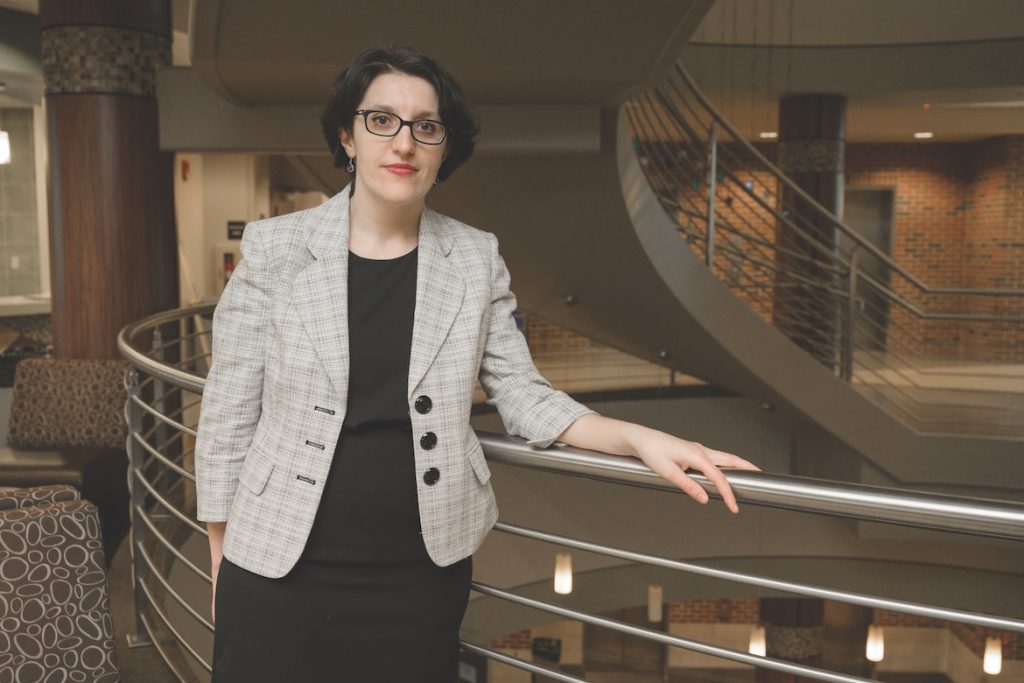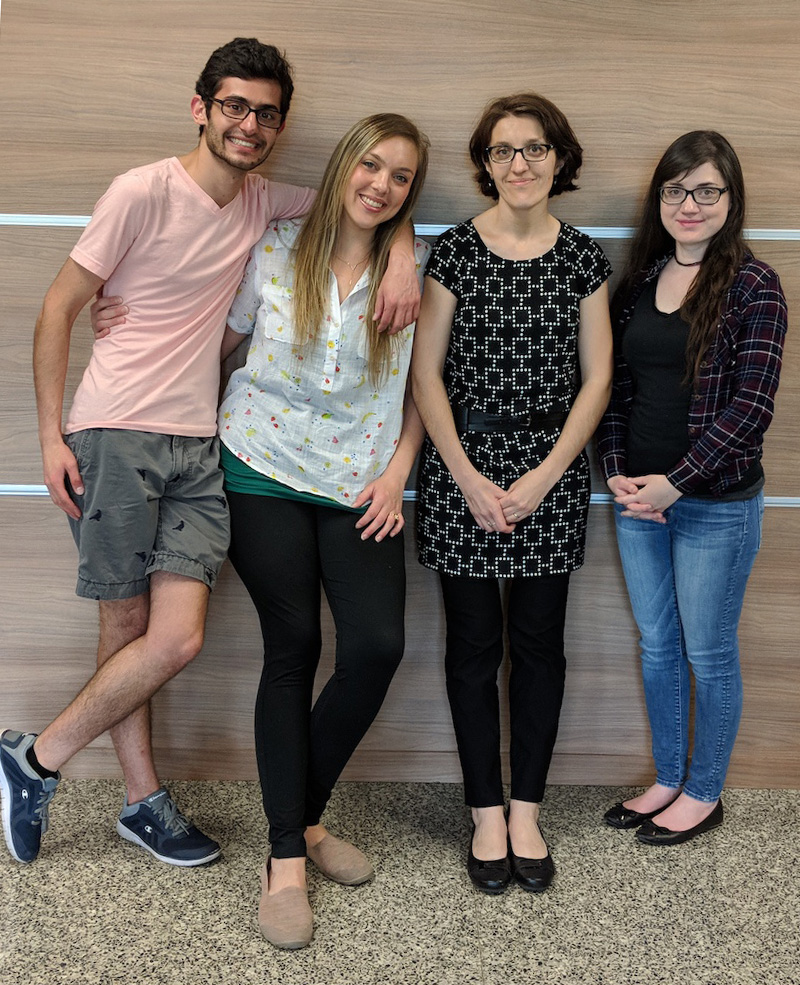National Science Foundation’s early career award opens up even more opportunities for Hanna Terletska and her students
Before Hanna Terletska became a Physics faculty member at MTSU in 2017, her son had celebrated his birthday in a different state each year because of several short-term postdoctoral positions.
“When we moved here, there was a full solar eclipse on his August birthday. We thought, ‘Ah, this is a sign. We will stay here,’ ” she said. “Indeed, his last three birthdays were in the same state.”
Terletska, considered a rising star in her field by peers, has seen even greater signs since then that MTSU was the right place at the right time. In 2020, she landed a nearly $500,000 Early Career Development (CAREER) grant from the National Science Foundation—a highly respected award that usually goes only to junior faculty at places like Harvard.
It was a first for MTSU, as Terletska and the College of Education’s Ryan Seth Jones became the University’s first two professors to earn the five-year federal grants. A few months later, Terletska was invited to share her research with almost 60 of the world’s leading physics scholars at the virtual Localisation 2020 conference, held in honor of Nobel Prize winner Philip W. “Phil” Anderson.
“Winning the NSF Early Career award is a milestone achievement that will advance Hanna’s research and open new doors for her students,” said Bud Fischer, outgoing dean of the College of Basic and Applied Sciences. “Dedicated, innovative educators like Dr. Terletska who actively engage students in the discovery process are a large part of what makes our college and University so special.”
Here are excerpts from Terletska’s comments about winning the award, her research, and more:
Could you describe the quantum materials research you’re conducting using the grant money?
My research is in computational study of quantum materials. The discovery of new materials is a cornerstone of human civilization and development. We now live in the era of quantum materials, which offer tremendous opportunities for fundamental research and advances in new-generation technologies. The potential benefits of 21st century technologies built on quantum materials are staggering. This includes quantum computers, highly efficient solar cells, and room-temperature superconductors that would generate, transmit, and store electricity with almost no loss. Hence, conquering the behavior of quantum materials can bolster economies, advance the quality of life, and address the unprecedented growth in global energy needs.

We call these materials “quantum” to highlight the exotic properties emerging in these materials coming purely from quantum physics effects. The magic comes from millions of thousands of interacting electrons, which at the atomic and subatomic scales start to also have wavelike properties. At this level, quantum physics really kicks in, and electrons start to exhibit quantum effects like tunneling, interference, entanglement, and topological order. Research in this field requires complex many-body numerical algorithms and access to powerful supercomputers. I use NSF-funded XSEDE supercomputing resources as well as access to the world’s most powerful computers at Oak Ridge National Laboratory (ORNL).
The discovery of new materials is a cornerstone of human civilization and development.
The breadth of transformative opportunities that quantum materials offer has ignited a worldwide race to control and exploit quantum matter and its integration in technology platforms. Governments all over the globe and large multinational companies have launched significant quantum material research initiatives and have invested heavily in related technologies and education. In 2018, the U.S. government signed a Quantum Initiative Act, making quantum material research a national priority. Over the last decade, numerous quantum research centers have emerged all across the United States, including the Appalachian Quantum Initiative in eastern Tennessee. Research in this field has brought together experts from across many disciplines, including physics, chemistry, engineering, material science, and computer science.

Terletska with three of four recent MTSU mentees who are now Ph.D. candidates
How has the grant award changed or helped your research?
The NSF-funded research opens up a lot of opportunities not just to my research group, but also for my students and for MTSU. It provides resources that allow me to stay fully research-focused and active, as well as get invitations for talks at other universities and national/international conferences. Quantum research is at high demand now, and this award helps me a lot with continuing inter-institutional and international collaborations. Nowadays, I collaborate with scholars from the University of Michigan, Florida State University, Louisiana State University, Carnegie Mellon University, Oak Ridge National Lab, Augsburg University in Germany, and India. Having such an NSF-funded opportunity is particularly important for new faculty who are trying to establish their research groups and gain recognition in the field and the community, in addition to being educators at their universities.
Also, such an award is very beneficial for our students: Ph.D. and undergraduate students have the opportunity to be trained and conduct cutting-edge research in the field. I am particularly excited for my students, as the timing for their research is right. Our future is quantum, with a lot of exciting opportunities in academia and industry now and in the future. There is already a strong demand for a quantum workforce.
After receiving the award, I got more opportunities to work closer with the NSF. I am grateful that the NSF really strives to be inclusive and diverse in the way they fund faculty research. Funding researchers like me not only assists with our personal research, but also is a big investment in research-growing universities like MTSU. MTSU has unique opportunities: We live in one of the nation’s fastest-growing counties, and being in close proximity to Nashville helps attract a lot of talented students. The wider spectrum of educational and research opportunities we can offer our students will provide a better education for them and develop a diversity of skills they will need for future jobs—which will help attract more talent here.
Our future is quantum, with a lot of exciting opportunities in academia and industry.
Were you surprised to receive this prestigious award?
To be honest, when the NSF called, I was shocked—I think we all were a little shocked. I even thought they would call me back in few days saying, “Sorry, we made a mistake.” It is very rare to earn such an award from the first try—usually it takes three tries to get it, if ever. Also, judging from the list of winners and the fact that MTSU has never received such an award before, I thought the level of award is more for the very top R1 (Tier 1 research) universities. This award is truly a great honor and a huge responsibility on my side and for MTSU. We are working very hard to use this opportunity to the full extent.
I am happy for another reason: When applying, I was very doubtful because places like MTSU—we are still building the research infrastructure here—don’t receive such high honors. I think this serves as a great example and encouragement for other new faculty here at MTSU and for universities like ours. It is doable. Also, I hope it will help attract other talented new faculty to MTSU.
How has MTSU supported your research?
The first thing I did when I got this award was send many thank-you emails to all my mentors here, who helped me so much during the grant application process and during my first two years at MTSU. Several factors made this success possible. Having a reduced teaching load as new faculty helped me a lot. In my first year at MTSU, I also obtained a Faculty Research and Creative Activity Committee award, which I think played an important role in establishing my research group here and in collaborations. It allowed me to travel to the University of Michigan and to ORNL, where I began collaborating with several researchers who ended up being collaborators on the grant.
Could you talk about any other research or projects you have?
In addition, I am a principal investigator on another NSF grant, where I am involved in a collaborative research on taming the effects of disorder and impurities in real materials. This research direction is more in the material science area. The beauty of research is that you never know what the next place is it is going to take you. Based on results from previous research, I have started new collaborations with researchers from the University at Albany and LSU on the non-equilibrium quantum systems and topological materials, respectively. These are very exciting areas of research, and I am looking forward to new adventures there too.
The first thing I did when I got this award was send many thank-you emails to all my mentors here.
How has the pandemic affected research for you and research opportunities for students?
There are already some research studies showing that COVID-19 was particularly hurting female faculty productivity. I have faced similar issues as many other mom-professors: Juggling child care, online school, teaching, Zoom lesson preparation, and research was hard. Due to the lack of child care, spring and summer 2020 were particularly hard. The nature of our research (it is all on computers) allows us to still do research with students, and we adapted to Zoom weekly research meetings and online communication. I ended up “traveling” a lot virtually during this time, giving about 15 invited talks since COVID-19 started.

Terletska (seated) with classmates at her university in Ukraine.
What made you choose physics as your area of study and as a career path?
A short answer: my teachers. I am a first-generation college student—no one in my family was particularly good in physics or went to college. I always liked to study and learn. I was not particularly into experiments or building things (I guess an early indication that I would become a theorist). But I was really good in problem-solving. Each year, my school would send me to a Science Olympiad in physics, chemistry, and math. While I like math, physics was much more interesting and challenging, and I liked that it helped to logically explain things around us and how they work.
Our middle school physics teacher played an important role in my choosing physics. I vividly remember how much he was devoted to teaching physics and cared that we loved it too. When time came for college, I decided to major in physics. It is funny—I remember my mom trying to make me doubt my choice. She thought mathematics is more for females and is more prestigious (haha) than physics. Indeed, the perception that physics or STEM is for boys is very common. But we had 15 women and two men in our class of physics majors at my college, and the boys did not graduate with all of us. Here at MTSU, I have established the Women in Physics student group so women can get the support, mentoring, and encouragement to pursue their careers in physics. It already has played an important role, as many of our members end up going to grad school.
What my parents constantly emphasized and valued is that education is the key! They often told me that education is the ticket to a better life. And, indeed, because of physics I immigrated to the United States. I came here for my graduate study, first for the M.S. at Minnesota State, then a Ph.D. at Florida State University, followed by several postdoctoral trainings at the Brookhaven National Lab, LSU, Ames Lab, and University of Michigan, and finally the faculty position at MTSU.
Here at MTSU, we have many first-generation college students, who don’t get much advice or guidance from their family members regarding college or their career path. Having good mentors often plays a deterministic role in their lives. Being a first-generation college student myself helps me understand those challenges even better. These are typically very, very talented students, but because of the lack of examples and support, they often don’t even dare to follow the opportunities available for them. Recently, I had the honor to mentor four such Physics majors who now are pursuing doctorates in Physics in the top prestigious universities of the U.S. These kids will have a very different future now—and their families too.


COMMENTS ARE OFF THIS POST